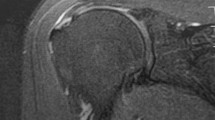Abstract
Purpose
The purpose of this study is to compare the clinical and subjective difference between transtendon repair or complete/repair in two homogeneous groups of patients affected by deep partial articular supraspinatus tear.
Methods
Seventy-four patients were randomized in two groups of 37 patients each. The first group (A) was treated with arthroscopic transtendon repair while the second group (B) was treated with an arthroscopic completion of the tear and formal repair. All the patients were revaluated at a minimum 2 years of follow-up with Constant score and Visual Analogic Scale (VAS).
Results
Constant score improved by a mean value of 25 (95 % CI 21–28) (p < 0.0001) and of 29 (95 % CI 26–31) (p < 0.0001), respectively; VAS score decreased by a mean value of 3.4 (95 % CI 2.9–3.9) (p < 0.0001) and of 3.6 (95 % CI 3.3–4.0) (p < 0.0001), respectively. The improvement was higher in both groups for the ADL, and in Group B, the improvement in strength was higher than in Group A. There were no statistical differences between the two different techniques.
Conclusion
Both repairing techniques of deep partial supraspinatus tear provide good results in terms of function and pain. There were no statistically significant differences between the two techniques.
Level of evidence
Prospective comparative study, Level II.
Similar content being viewed by others
References
Andrews JR, Broussard TS, Carson WG (1985) Arthroscopy of the shoulder in the management of partial tears of the rotator cuff: a preliminary report. Arthroscopy 1:117–122
Brockmeier SF, Dodson CC, Gamradt SC, Coleman SH, Altchek DW (2008) Arthroscopic intratendinous repair of the delaminated partial-thickness rotator cuff tear in overhead athletes. Arthroscopy 24:961–965
Castagna A, Delle Rose G, Conti M, Snyder SJ, Borroni M, Garofalo R (2009) Predictive factors of subtle residual shoulder symptoms after transtendinous arthroscopic cuff repair: a clinical study. Am J Sports Med 37:103–108
Codman E (1934) The shoulder: rupture of the supraspinatus tendon and other lesions in or about the subacromial bursa, RE Kreiger. ISBN: 0898747317
Ellman H (1990) Diagnosis and treatment of incomplete rotator cuff tears. Clin Orthop Relat Res 254:64–74
Fukuda H, Hamada K, Nakajima T, Tomonaga A (1994) Pathology and pathogenesis of the intratendinous tearing of the rotator cuff viewed from en bloc histologic sections. Clin Orthop Relat Res 304:60–67
Gonzalez-Lomas G, Kippe MA et al (2008) In situ transtendon repair outperforms tear completion and repair for partial articular-sided supraspinatus tendon tears. J Shoulder Elbow Surg 17:722–728
Habermeyer P, Krieter C, Tang KL, Lichtenberg S, Magosch P (2008) A new arthroscopic classification of articular-sided supraspinatus footprint lesions: a prospective comparison with Snyder’s and Ellman’s classification. J Shoulder Elbow Surg 17:909–913
Ide J, Maeda S, Takagi K (2005) Arthroscopic transtendon repair of partial-thickness articular-side tears of the rotator cuff: anatomical and clinical study. Am J Sports Med 2005(33):1672–1679
Itoi E, Tabata S (1992) Incomplete rotator cuff tears. Results of operative treatment. Clin Orthop Relat Res 284:128–135
Kuhn JE, Dunn WR, Ma B et al (2007) Interobserver agreement in the classification of rotator cuff tears. Am J Sports Med 35:437–441
Lo IK, Burkhart SS (2004) Transtendon arthroscopic repair of partial-thickness, articular surface tears of the rotator cuff. Arthroscopy 20:214–220
Randelli P, Arrigoni P, Lubowitz JH, Cabitza P, Denti M (2008) Randomization procedures in orthopaedic trials. Arthroscopy 24:834–838
Reynolds SB, Dugas JR, Cain EL, McMichael CS, Andrews JR (2008) Debridement of small partial-thickness rotator cuff tears in elite overhead throwers. Clin Orthop Relat Res 466:614–621
Snyder S (2003) Arthroscopic classification of rotator cuff lesions and surgical decision making. In: Snyder S (ed) Shoulder arthroscopy, 2nd edn. Lippincott Williams & Wilkins, Philadelphia, pp 201–207
Snyder SJ, Pachelli AF, Del Pizzo W, Friedman MJ, Ferkel RD, Pattee G (1991) Partial thickness rotator cuff tears: results of arthroscopic treatment. Arthroscopy 7:1–7
Weber SC (1999) Arthroscopic debridement and acromioplasty versus mini-open repair in the treatment of significant partial-thickness rotator cuff tears. Arthroscopy 15:126–131
Wolf E (1998) Purely arthroscopic rotator cuff repair. In: Current techniques in arthroscopy, 3rd edn. Thieme, New York, pp 79–86
Yamanaka K, Matsumoto T (1994) The joint side tear of the rotator cuff. A followup study by arthrography. Clin Orthop Relat Res 304:68–73
Author information
Authors and Affiliations
Corresponding author
Rights and permissions
About this article
Cite this article
Castagna, A., Borroni, M., Garofalo, R. et al. Deep partial rotator cuff tear: transtendon repair or tear completion and repair? A randomized clinical trial. Knee Surg Sports Traumatol Arthrosc 23, 460–463 (2015). https://doi.org/10.1007/s00167-013-2536-6
Received:
Accepted:
Published:
Issue Date:
DOI: https://doi.org/10.1007/s00167-013-2536-6




